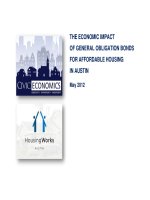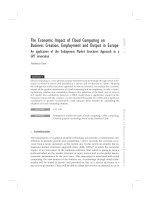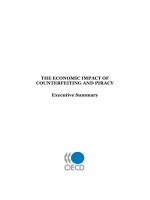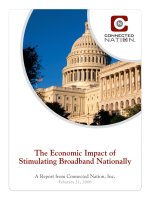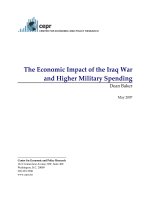Assessing the economic impact of tourism a computable general equilibrium modelling approach
Bạn đang xem bản rút gọn của tài liệu. Xem và tải ngay bản đầy đủ của tài liệu tại đây (5.81 MB, 247 trang )
Samuel Meng and Mahinda Siriwardana
Assessing the Economic Impact of Tourism
A Computable General Equilibrium Modelling Approach
Samuel Meng
University of New England, Armidale, New South Wales, Australia
Mahinda Siriwardana
University of New England, Armidale, New South Wales, Australia
ISBN 978-3-319-40327-4 e-ISBN 978-3-319-40328-1
DOI 10.1007/978-3-319-40328-1
Library of Congress Control Number: 2016956078
© The Editor(s) (if applicable) and The Author(s) 2017
This work is subject to copyright. All rights are solely and exclusively licensed by the Publisher,
whether the whole or part of the material is concerned, specifically the rights of translation,
reprinting, reuse of illustrations, recitation, broadcasting, reproduction on microfilms or in any other
physical way, and transmission or information storage and retrieval, electronic adaptation, computer
software, or by similar or dissimilar methodology now known or hereafter developed.
The use of general descriptive names, registered names, trademarks, service marks, etc. in this
publication does not imply, even in the absence of a specific statement, that such names are exempt
from the relevant protective laws and regulations and therefore free for general use.
The publisher, the authors and the editors are safe to assume that the advice and information in this
book are believed to be true and accurate at the date of publication. Neither the publisher nor the
authors or the editors give a warranty, express or implied, with respect to the material contained
herein or for any errors or omissions that may have been made.
Cover illustration: Cover image © Infografx / Alamy Stock Photo
Printed on acid-free paper
This Palgrave Macmillan imprint is published by Springer Nature The registered company is
Springer International Publishing AG The registered company address is: Gewerbestrasse 11, 6330
Cham, Switzerland
Abbreviations
AOR Average Occupancy Rate
ARR Average Room Rate
ASEAN Association of Southeast Asian Nations
BOT Balance of Trade
CD Cobb–Douglas
CES Constant Elasticity of Substitution
CET Constant Elasticity of Transformation
CGE Computable General Equilibrium
CNTA China National Tourism Administration
COE Certificate of Entitlement
CPF Central Provident Fund
CPI Consumer Price Index
CRS Constant Returns to Scale
DOS Department of Statistics
DTD Double Tax Deduction
EV Equivalent Variation
F&B Food and Beverage
FMD Foot-and-Mouth Disease
FTA Free Trade Agreement
FTE Full-Time Equivalent
GDP Gross Domestic Product
GFC Global Financial Crisis
GST Goods and Service Tax
GTAP Global Trade Analysis Project
ICT Information Communication Technology
I–O Input–Output
IT Information Technology
LES Linear Expenditure System
MICE Meetings, Incentive travel, Exhibitions and Conventions
MMRF Monash Multi-Regional Forecast
MOM Ministry of Manpower
MRT Mass Rapid Transit
MTI Ministry of Trade and Industry
NCB National Computer Board
PMB Preservation of Monuments Board
RoW Rest of World
RWC Rugby World Cup
SARS Severe Acute Respiratory Syndrome
SPG South Pacific Games
STB Singapore Tourism Board
STPB Singapore Tourism Promotion Board
TDAS Tourism Development Assistance Scheme
TEV Total Expenditure of Visitors
TPF Tourism Policy and Forecasting
TR Tourism Receipts
TSA Tourism Satellite Account
UK United Kingdom
UNCTAD United Nations Conference on Trade and Development
UNWTO United Nations World Tourism Organization
USA United States of America
WTTC World Travel and Tourism Council
Contents
1 An Introduction to CGE Modelling
1.1 What Is a CGE Model?
1.2 A Brief Historical Review of CGE Modelling
1.2.1 Walras’ Law: The Theoretical Foundation for CGE Modelling
1.2.2 Input–Output Analysis: The Predecessor of CGE Modelling
1.2.3 Advent of CGE Modelling
1.3 Elements of a Standard CGE Model
1.3.1 Elements in CGE Model Structure
1.3.2 Elements in CGE Database
1.4 Types of CGE Models
1.4.1 Static Versus Dynamic CGE Models
1.4.2 Single-Country Versus Global CGE Models
1.4.3 Single-Region Versus Multi-Regional CGE Models
1.4.4 Top-Down Versus Bottom-Up CGE Models
1.4.5 Multi-Household and/or Multi-Occupation CGE Models
1.4.6 CGE Models by Research Area
1.5 Acceptance of CGE Modelling
1.6 An Evaluation of CGE Modelling
1.6.1 Advantages of a CGE Model Over Other Simulation Models
1.6.2 Drawbacks of CGE Modelling
References
2 Useful CGE Modelling Packages
2.1 GEMPACK Versus GAMS
2.1.1 Advantages of a Linear Model
2.1.2 Percentage Change Linearization Approach
2.1.3 Multi-Step Process to Minimizing the Linearization Errors
2.2 How to Use GEMPACK to Do a Simulation
2.2.1 Using RunGEM
2.2.2 Using WinGEM
2.2.3 Viewing Simulation Results
2.3 How to Use GEMPACK to Construct/Change a Model
2.3.1 Creating a TAB File
2.3.2 Creating a HAR File
2.3.3 Creating a CMF File
2.3.4 Creating an STI File
References
3 Application of CGE Modelling to Tourism
3.1 Suitability of a CGE Model in Tourism Analysis
3.2 Assessing the Impact of Tourism Demand and Tourism Policy
3.3 Assessing the Impact of Mega Events on Tourism and on the Economy
3.4 Assessing the Impact of Tourism on the Environment and Natural Resources
3.5 Assessing the Distributional Effect of Tourism
References
4 Collecting Background Information for a Tourism CGE Model
4.1 Information on Economic Structure and the Role of Tourism
4.1.1 General Feature of Singaporean Economy and Its Implications
4.1.2 Manufacturing Sector
4.1.3 Trade, Hotels, and Restaurants
4.1.4 Financial and Business Services
4.1.5 Transportation and ICT Services
4.1.6 Linkages Among Sectors
4.2 Information on Tourism Resources
4.2.1 Favourable Geographic Position and Tropical Environment
4.2.2 Colonial Historical Legacy
4.2.3 Sound Infrastructure and Efficient Service
4.3 Performance of the Tourism Sector
4.3.1 International Comparison
4.3.2 Performance over Time
4.3.3 Performance of the Hospitality Industry
4.4 Characteristics of Tourism Market
4.4.1 A Holiday and Business/MICE Destination
4.4.2 Diverse but Uneven Tourism-Generating Markets
4.4.3 Gateway Tourism
4.4.4 Tourism Shopping and Health Tourism
4.5 Information on Tourism Policies
4.5.1 Modernist Aspiration (1965–1985)
4.5.2 Heritage Tourism (1986–1995)
4.5.3 Tourism Capital (1996–Present)
References
5 Constructing a Tourism CGE Model
5.1 How to Incorporate Tourism into a CGE Model
5.1.1 Creating a Real Tourism Industry
5.1.2 Creating a Shadow Tourism Industry
5.1.3 Modelling the Tourism Industry Directly from the Demand Side
5.1.4 The Overview of a Tourism CGE Model
5.2 Production of Goods and Services
5.2.1 Demand for Composite Inputs
5.2.2 Demand for Intermediate Inputs
5.2.3 Demand for Primary Factors
5.2.4 Output Mix
5.3 Investors’ Demand
5.4 Household Utility
5.5 Tourism Demand
5.5.1 Demand for Composite Tourism Services
5.5.2 Demand for Tourism Shopping and Non-Shopping Services
5.5.3 Tourism Shopping Expenditure Pattern
5.5.4 Tourism Non-Shopping Services Demand
5.5.5 TABLO Codes for Tourism Demand
5.6 Exports and Other Final Demands
5.6.1 Foreign Demand for Exports
5.6.2 Government Demand
5.7 The Price System
5.7.1 The Basic Values
5.7.2 The Purchasers’ Prices
5.8 Income, Consumption, and Investment
5.8.1 Household Income, Consumption, and Budget Constraint
5.8.2 Government Income
5.8.3 Investment and Capital Accumulation
5.9 Imports, Exports, and Balance of Trade
5.10 Price Indices, Wage Indexation, and GDP Price Deflator
5.11 Market Clearing Equations
5.12 The Complete Model
References
6 Preparing Database for a Tourism CGE Model
6.1 Data Requirements
6.1.1 I–O Data
6.1.2 Other Data
6.2 Data Availability and Sources
6.2.1 Singaporean I–O Tables
6.2.2 Other Sources
6.3 Model Accounts
6.3.1 Production Account
6.3.2 Household Account
6.3.3 Tourism Account
6.3.4 Sectoral Employment
6.3.5 Investment Matrices
6.3.6 Tax Matrices
6.4 Behavioural Parameters
6.4.1 Input Substitution Elasticities
6.4.2 Products Transformation and Export Demand Elasticities
6.4.3 Tourism Demand and Tourism Substitution Elasticities
6.4.4 Frisch Parameter and Household Expenditure Elasticities
References
7 Model Implementation and Testing
7.1 The Integrity of Model Implementation
7.1.1 The Accuracy and Consistency of Data
7.1.2 The Rigorous Simulation Procedure in GEMPACK
7.1.3 Model Validity Tests
7.2 Simulation Design
7.2.1 Economic Environment for Simulation
7.2.2 Simulation Plans
7.3 Sensitivity Tests
7.3.1 Testing Tourism and Export Demand Elasticities
7.3.2 Testing Wage Indexation and Product Transformation Elasticities
7.3.3 Testing Substitution Elasticities
7.3.4 Systematic Sensitivity Analysis
References
8 Interpretation of Results from a Tourism CGE Model
8.1 The Impact of Disaggregated Tourism Demand
8.1.1 The Macroeconomic Effects
8.1.2 The Sectoral Effects
8.1.3 Employment Effects
8.2 The Impact of Negative Mega Events and Policy Responses
8.2.1 The Macroeconomic Effects
8.2.2 The Tourism Effects
8.2.3 The Sectoral Effects
8.2.4 The Employment Effects
8.3 The Effectiveness of Singaporean Tourism Policies
8.3.1 The Macroeconomic Effects
8.3.2 The Tourism Effects
8.3.3 The Sectoral Effects
8.3.4 The Employment Effects
References
9 Frontiers of Tourism CGE Modelling
9.1 Modelling Tourism in a Richer Environment
9.2 Modelling Tourism with a Multi-Regional CGE Model
9.3 Modelling Tourism with a Global Context
9.4 Modelling Tourism Using a Dynamic CGE Model
Index
List of Figures
Fig.1.1 Market equilibrium
Fig.1.2 An illustration of economic system in a CGE model
Fig.1.3 Comparative static interpretation of results in ORANI-G
Fig.2.1 Johansen linearization error
Fig.2.2 Multi-step process to reduce linearization error
Fig.2.3 The RunGEM interface
Fig.2.4 The interface for TABLO implement
Fig.2.5 ViewSOL interface
Fig.2.6 ViewHAR interface
Fig.2.7 Interface of ‘create new set’
Fig.2.8 Interface of ‘create headers’
Fig.2.9 Interface of a har file header with default value
Fig.2.10 The interface of ‘create mappings’
Fig.2.11 The interface of data aggregation
Fig.4.1 Visitor arrivals by visiting purpose in recent years
Fig.4.2 Visitor arrivals by region in 2006
Fig.4.3 Top ten visitor arrivals by country in 2006
Fig.4.4 Top ten tourism-generating markets by TEV in 2006
Fig.4.5 Breakdown of TEV in 2006
Fig.4.6 Top ten tourism shoppers in 2006
Fig.5.1 Production of goods and services
Fig.5.2 Investors’ demand
Fig.5.3 Household utility
Fig.5.4 Tourism demand
Fig.7.1 Steps in carrying out a simulation in GEMPACK
Fig.7.2 Macroeconomic closure in the long run
Fig.7.3 Macroeconomic closure in the short run
Fig.7.4 Results of sensitivity tests for substitution elasticities
List of Tables
Table 4.1 Overall economic structure of Singapore
Table 4.2 Sector share of total value-added, 1960–2007
Table 4.3 Structure of manufacturing industry
Table 4.4 Investment commitments in manufacturing industry
Table 4.5 Singapore’s top ten imports and exports in terms of value
Table 4.6 Structure of financial and business services industry
Table 4.7 Structure of transport and storage sector
Table 4.8 Employment linkages between sectors
Table 4.9 Intermediate demand in business sectors in 2000
Table 4.10 World top 15 city destinations 2006
Table 4.11 Top ten cities by number of meetings 2006
Table 4.12 Visitor arrivals and tourism receipts in Singapore from 1991 to 2005
Table 4.13 TEV and TR from 1998 to 2006
Table 4.14 Standard average occupancy rate (AOR) and average room rate (ARR)
Table 4.15 Supply of hotels and hotel rooms at the end of the year, 1997–2006
Table 4.16 Sales turnover of Cessable hotels and other F&B establishments (S$ Million)
Table 4.17 Visitor arrivals by gender and age group
Table 4.18 Top ten tourism-generating markets by visitor arrivals in recent years
Table 4.19 Average per capita expenditure for top ten tourism-generating countries ($)
Table 4.20 Visitor arrivals by length of stay in recent years (thousands)
Table 4.21 Number of air passengers 1980–1994
Table 4.22 Distribution of tourism expenditure on major items (%), 2001–2006
Table 4.23 Distribution of tourism shopping items (%)
Table 5.1 Equations in the model
Table 5.2 Variables in the model
Table 5.3 Parameters and shares in the model
Table 6.1 Absorption matrix
Table 6.2 Make matrix
Table 6.3 Tariff vector
Table 6.4 Commodity analyses of purchases from domestic production, 2005 (Absorption matrix)
Table 6.5 Commodity analysis of domestic output, 2005 (Make matrix)
Table 6.6 Commodity analysis of retained imports, 2005 (Import matrix)
Table 6.7 Mapping from I–O 2005 to aggregate I–O tables
Table 6.8 Breakdown of major tourism expenditure items
Table 6.9 Shopping items purchased as percentage of total shopping expenditure
Table 6.10 Tourism expenditure by source region
Table 6.11 Employment by industry, 2006 (as at December 31)
Table 6.12 Employed residents aged 15 and over by industry and occupation (thousands), June 2006
Table 6.13 Monthly gross wage of major occupation groups by industry, June 2006
Table 6.14 Sectoral capital stock in Singapore ($ Million)
Table 6.15 The source and factor substitution elasticities for the model
Table 6.16 Singaporean household expenditure elasticities
Table 7.1 Results of sensitivity tests for tourism and export demand elasticities
Table 7.2 Results of sensitivity tests for supply and product transformation elasticities
Table 7.3 The results of systematic sensitivity tests
Table 8.1 Macroeconomic effects of tourism components in the short run
Table 8.2 Macroeconomic effects of tourism components in the long run
Table 8.3 Effects of tourism components on sectoral output in the short run
Table 8.4 Effects of tourism components on sectoral output in the long run
Table 8.5 Effects of tourism components on occupational employment in the short run
Table 8.6 Effects of tourism components on occupational employment in the long run
Table 8.7 Macroeconomic effects of a negative mega event and policy responses
Table 8.8 Tourism effects of a negative mega event and policy responses
Table 8.9 Effects on sectoral output of a negative mega event and policy responses
Table 8.10 Effects on sectoral profitability of a negative mega event and policy responses
Table 8.11 Effects on sectoral employment of a negative mega event and policy responses
Table 8.12 Occupational employment effects of a negative mega event and policy responses
Table 8.13 Macroeconomic effects of Singapore tourism policies in the long run
Table 8.14 Tourism effects of Singapore tourism policies in the long run
Table 8.15 Effects on sectoral output of Singapore tourism policies in the long run
Table 8.16 Effects on sectoral profitability of Singapore tourism policies in the long run
Table 8.17 Effects on sectoral employment of Singapore tourism policies in the long run
Table 8.18 Occupational employment effects of Singapore tourism policies in the long run
© The Author(s) 2017
Samuel Meng and Mahinda Siriwardana, Assessing the Economic Impact of Tourism, DOI 10.1007/978-3-319-40328-1_1
1. An Introduction to CGE Modelling
Samuel Meng1 and Mahinda Siriwardana1
(1) University of New England, Armidale, New South Wales, Australia
1.1 What Is a CGE Model?
The name ‘computable general equilibrium (CGE) model’ indicates the main features of this type of
model. Equilibrium is a common economic term which means a system reaches a relatively stable
state. For example, fluctuations of demand for and supply of apples will cause a change in apple
prices: when demand for apples is greater than the supply of apples, apple price will go up, and vice
versa. However, over time, the demand and supply will reach a balance and thus the price of apples
will be relatively stable. This can be shown as a basic supply and demand graph below.
In Fig. 1.1, at price P1, demand at point B is greater than supply at point A, so the excess demand
will pull the price up. At price P2, the demand at point C is less than the supply at point D, the excess
supply will push the price down. Only at point E, are supply and demand balanced, so the price (Pe)
and quantity (Qe) of apples are stable. Point E is called the equilibrium in the apples market.
However, this graph only concerns the equilibrium of one market (the apple market). In reality,
different markets are interconnected with each other. For example, the apple market and the stone fruit
market are closely related. If there is a sudden drop in supply of stone fruits, their price will go up.
Facing the increased price of stone fruits, people tend to buy fewer stone fruits but buy more apples.
This will cause an increase in apply demand and thus an increase in apple price. In other words, the
originally equilibrium in apple market is affected by the condition in the stone fruit market. In this
reasoning, equilibrium in the economy can be achieved only when all markets are in equilibrium. This
is the concept of general equilibrium. A CGE model can simulate the outcome when the whole
economy is in general equilibrium.
Fig.1.1 Market equilibrium
A CGE simulation generally starts with a general equilibrium situation (a baseline case or a
business-as-usual case). Then a shock (e.g. a tax policy or an event such as the Global Financial
Crisis) is introduced and the CGE model can generate the new general equilibrium situation. The term
‘computable’ in CGE modelling indicates that a CGE model is able to quantify the effect of a shock.
Since there are numerous markets in an economy, to model a general equilibrium involves a large
amount of data, so it is common that a computer is used in CGE modelling. The term ‘computable’
also implies that a computer is involved in CGE modelling.
1.2 A Brief Historical Review of CGE Modelling
1.2.1 Walras’ Law: The Theoretical Foundation for CGE Modelling
As early as in 1874, Walras (1954) showed that equilibrium conditions in different markets in an
economy are not independent and general equilibrium is available at any set of prices. Arrow and
Debreu (1954), Debreu (1959), and Arrow and Hahn (1971) turned Walrasian general equilibrium
theory into the Arrow–Debreu framework, in which consumers who possess an endowment of factors
and commodities are assumed to maximize utility; producers are assumed to maximize profits; market
demand for and supply of any commodity are continuous, non-negative, homogeneous of degree zero,
and subject to the condition that, at any set of prices, the total value of consumer expenditure equals
consumer income. There are four types of equations in this framework: (1) The equations for
equilibrium conditions for each market to ensure that supply equals demand for each good and
service; (2) the equations for income–expenditure identities to ensure the balance of each account; (3)
the equations for behavioural relationships to describe economic agents’ reactions to changes in
prices and incomes; and (4) the equations for production functions to determine the output for each
sector and how the factors of production are allocated. This framework forms the foundation for CGE
modelling.
1.2.2 Input–Output Analysis: The Predecessor of CGE Modelling
Input–output (I–O) analysis is based on Walrasian general equilibrium theory and relies on the I–O
table. The advantage of this analysis is that it can take into account inter-industry linkages.
Although the idea of inter-industry linkage can be traced back to 1758 when Quesnay published a
‘Tableau Economique’ and the Leontief model is an approximation of Walrasian general equilibrium
theory (Miller and Blair 1985), Leontief was thought to be the father of the I–O model due to the fact
that he was the first economist to present a theoretical framework along with the I–O structure of the
US economy (Leontief 1936, 1941). The structure of the Leontief I–O model has been reinterpreted
again and again by many different researchers. Here we present the fundamental structure of the I–O
model as interpreted by Miller and Blair (1985).
In reality, these changes in output, income, and employment may result from direct, indirect, and
induced effects. First, an increase in tourist expenditure will cause an immediate impact on the
economy. Tourist expenditure increases the sales revenues of firms directly catering to tourist needs.
This is called the ‘direct effect’. Second, as the sales revenues increase, the firms and organizations
in the tourism industry will purchase goods and services from various suppliers who in turn purchase
inputs from other firms, and so on. This increased intermediate demand is called the ‘indirect effect’.
Third, the direct and indirect expenditures increase household income. As the recipients of the direct
and indirect expenditures (i.e. the owners of the firms and their employees) spend their increased
incomes, the demand for goods and services will increase again, setting off a process of successive
rounds of purchases and further consumption. This effect is known as the ‘induced effect’. Because of
the indirect and induced effects of tourist expenditure, the ultimate increase in total value added, and
employment will be much higher than the initial increase in value added and employment in the
tourism industry.
The use of I–O analysis was popular in tourism analyses in the 1950s to 1980s because of its
ability to estimate the aggregate as well as the sectoral-level economic impacts, and to trace the
linkages between industries. However, I–O analysis is subject to some serious shortcomings due to
its strict and unrealistic assumptions. These limitations have been widely criticized by CGE
modellers (see Briassoulis 1991; Johnson 1999; Blake 2000; Dwyer et al. 2004, 2006).
The obvious drawback of an I–O model is that the I–O ratios are assumed fixed. This is far from
the reality and too mechanical. As a result, the model is very rigid and lacks explanatory power. It
may be argued that the fixed technical coefficients reflect the fixed technology at a point of time. The
immediate response is that technology does change over time and there are many alternative
production methods available at any point of time. Since there are different kinds of production
functions we can employ to describe production activities, only using the most rigid (and most
convenient) one for all industries in the economy is unrealistic.
The other assumption of I–O analysis is that there are no constraints on the capacity of an industry
to expand production to meet the additional demands by tourists. This assumption is of course
unrealistic as resources are scarce in any economy. This assumption has a number of implications.
First, it will exclude any price effects. Since the resources needed for producing additional products
are readily available, an expansion of production would not cause any input price change, and thus
changes in the demand for the factors of production would not induce any change in the cost. In
reality, this is not the case as industrial sectors would have to compete for scarce resources, thus
raising the price of factors of production in the face of stronger tourism demand. Second, it rules out
the possibility of firms utilizing substitution between factors. As tourism demand pulls up the prices
of some inputs, firms will use less of these inputs and use more substitutes in order to minimize cost.
However, the fixed I–O ratios in an I–O model fail to reflect firms’ behaviour of cost minimization.
Third, the I–O analysis based on this assumption cannot take account of any feedback effect—the
general equilibrium adjustment due to the relocation of resources among industries. For example, in
the case of tourism expansion, an I–O model does not allow for the amount of labour flowing from
other industries to the tourism industry and the consequent reduction in production of other industries.
It also does not allow for the effects of foreign tourism demand pushing up exchange rates, which
discourage other exports and result in increased imports.
Some researchers refined the I–O modelling to overcome some of its limitations. For example,
Sadler et al. (1973) incorporated into the model the effects of changes in consumption patterns when
income rises; Wanhill (1988), Fletcher and Archer (1991), and West and Gamage (2001) introduced
capacity constraints into the basic model. However, these refinements fail to fully capture the general
equilibrium adjustment in the model.
1.2.3 Advent of CGE Modelling
The limitations of the I–O model cry out for a more realistic, flexible, and comprehensive general
equilibrium model. With the advent and development of computer technology, the CGE model was
born and quickly gained popularity.
The early CGE models based on the Arrow–Debreu framework were set up under the conditions
of perfect competition (e.g. Dixon et al. 1982). It is criticized that the concept of perfectly
competitive market structure is not realistic for the modern economy, so some CGE models
incorporating imperfect competition have been developed. Harris (1984) developed a CGE model
for a small open economy with scale economies and imperfect competition. Later studies
incorporated industrial organization features into multi-country CGE models (e.g. Gasiorek et al.
1992; Harrison et al. 1996, 1997; Adams and Parmenter 1999), and some studies incorporated
dynamics into the CGE model to change the static nature of the CGE model (Auerbach et al. 1983;
Perroni 1995; Kotlikoff 1998; Dixon and Parmenter 1996; Dixon and Rimmer 2002; Madsen and
Sorensen 2002). However, the incorporation of imperfect competition and dynamics into the CGE
model increases the complexity of the model. Palstev (2000) claims that dynamic CGE models can
provide reasonably accurate predictions if there are no major structural changes in the economy and if
the future growth of fundamentals is easy to forecast, but in the case of great uncertainty, the forecasts
provided by the models tend to be less accurate.
1.3 Elements of a Standard CGE Model
A standard CGE model mainly includes two components: model structure and database. The CGE
model structure is actually a system of equations mimicking the economic interconnection in a real
economy. A CGE database includes all data to be fed into the CGE model structure in order to derive
simulation results. In this section, we discuss briefly the elements in both components.
1.3.1 Elements in CGE Model Structure
The economic system in reality is very complex and thus involves numerous elements. However, all
elements are directly or indirectly related to supply of and demand for goods and services. These are
the backbone of a CGE model. An economic system in a CGE model is illustrated in Fig. 1.2.
Fig.1.2 An illustration of economic system in a CGE model
There are many elements in Fig. 1.2, but the key elements are those in the square textbox with a
double line. The three key elements on the very left of the graph, that is, labour, capital, and
intermediate inputs, are the resources (or inputs) for producing a good or service (i.e. output). In an
equilibrium, this good or service must be purchased by different users (demands), for example,
intermediate demand, foreign demand, investor's demand, government demand, and household
demand. These different users (demands) are the key elements of the economic system, shown at the
bottom of the graph.
All other elements in the graph are linked to the key elements in different ways. First, it is worth
noticing the linkage between intermediate inputs and intermediate demand. The intermediate demand
for one commodity is also the intermediate inputs for production of other commodities, so the total
intermediate demand in the economy should equal the total supply of intermediate inputs. Second, the
production side is influenced by many factors. The real wage rates interact with both labour inputs
and labour supply while the rate of return on capital is the centre element on capital inputs and capital
stock. All these factors are the determining forces on sectoral output and gross domestic product
(GDP) in the economy. Finally, on the demand side, even more variables are involved. Take
household demand for example. The household demand for one commodity is greatly affected by total
household consumption that in turn is affected by household disposable income. The disposable
income is determined by both the income tax rate and gross household income, both of which are a
substantial part of GDP. These interactions among the macroeconomic variables make the economic
system complicated. A CGE model uses mathematical functions to present the behaviours of
economic agents as well as the interactions among the related variables. Through the equation system,
the model can evaluate the effect of the change of one or more variables on other variables in the
economy.
1.3.2 Elements in CGE Database
The database for a CGE model consists of two parts: parameter values and the flow of income and
spending in an economy. Parameters describe the behaviour of economic agents. For example,
substitution elasticity for apples and stone fruits can indicate how much a consumer will substitute
away from apples (buying fewer apples and more other fruits) when the apple price increases.
Parameter values are assigned to the equations in a CGE model and they keep unchanged when
